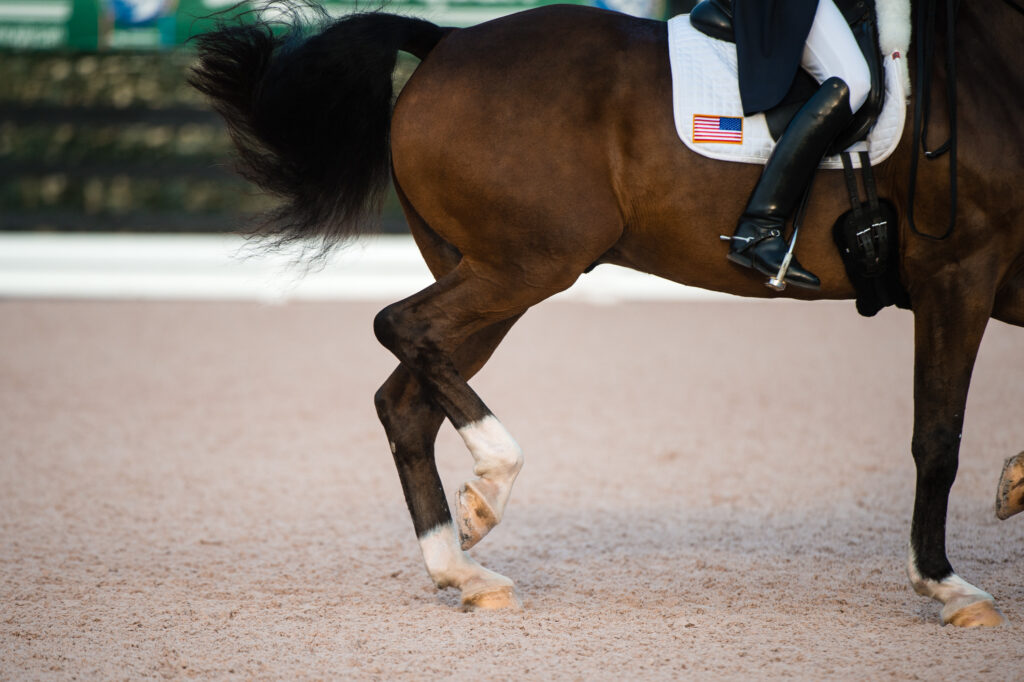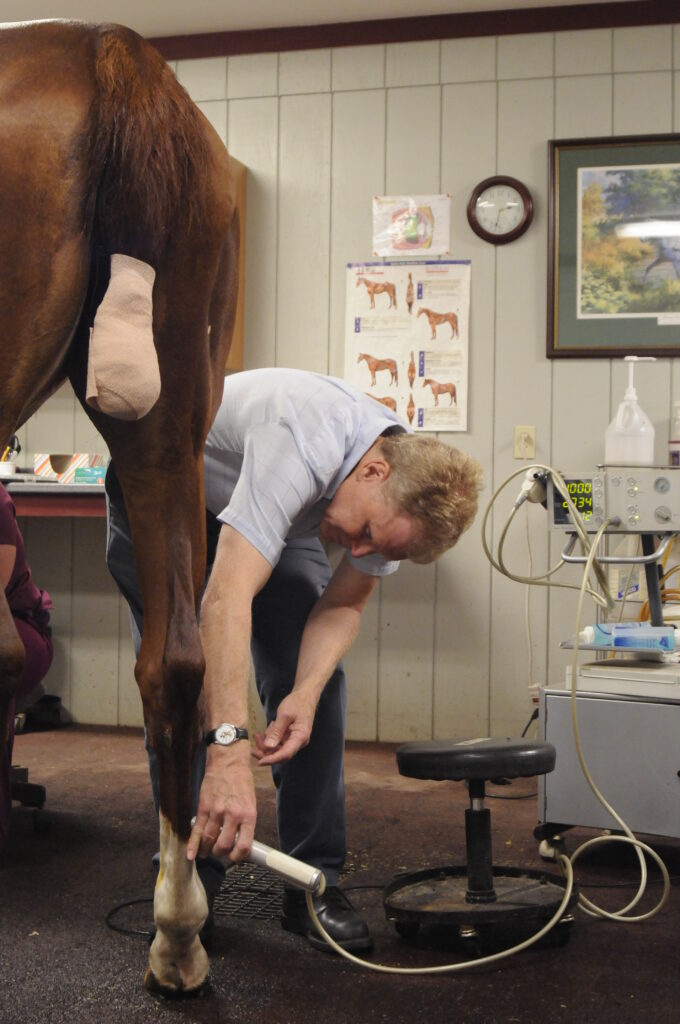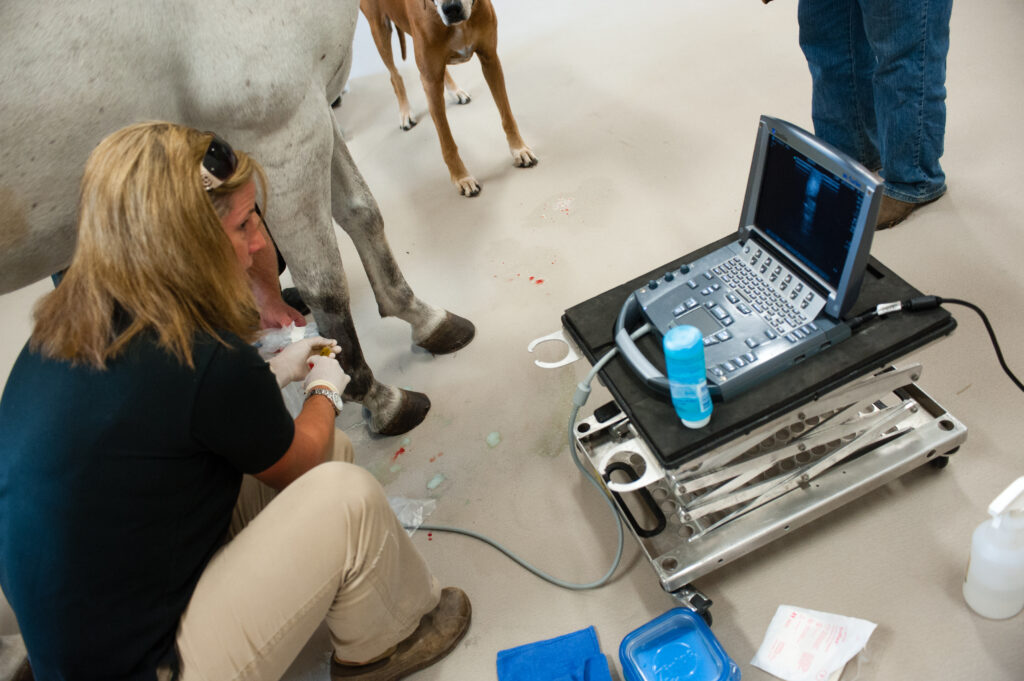Your jumper finished a clear round, but as soon as he broke to the trot you sensed he wasn’t right. Now, cooled out and back at the barn, he’s clearly lame. He doesn’t react when you apply hoof testers or probe along his legs with your fingers, though. Where’s the problem?

You’ve been schooling hard, perfecting your dressage horse’s collected trot for an upcoming show. Yesterday he seemed a little off in the left hind, but he looks fine today. You can’t find heat or swelling anywhere. Do you press on or give him more time off?
An unwelcome possibility in both these scenarios is a torn suspensory ligament, an injury that has the potential to limit or end your horse’s career. This ligament has an important role—it supports the horse’s fetlock—and full recovery from a serious tear is never certain. But “doing” a suspensory isn’t always a disaster. For this article, we asked Elizabeth Barrett, DVM, a sporthorse veterinarian with Hagyard Equine Medical Institute, in Lexington, Kentucky, to explain how a carefully monitored combination of treatment, rest and rehabilitation can help your horse make a full return to work.
Dr. Barrett says she sees two types of suspensory problems in her practice. One is a chronic degenerative condition that mainly affects older horses of certain breeds; the second type, strain injury, is the focus here. “Suspensory injuries are common in performance horses in all disciplines, not just jumping,“ she says. “Any athletic horse is at risk.”
How It Happens
The suspensory ligament’s job is to stretch to let the fetlock sink under the horse’s weight, absorbing shock and then spring back as the horse’s weight moves off the leg. It’s a band of fibrous elastic tissue that begins just behind the knee or hock, runs down the back of the cannon bone and splits into two branches about two-thirds of the way down. The branches latch onto the two sesamoid bones at the back of the fetlock joint and continue around the joint, one on the inside and one on the outside, to anchor below the fetlock on the long pastern bone.

The suspensory doesn’t work alone—a team of ligaments and other structures support the leg—but it’s an essential player. And if the horse overloads a leg, it can give way under the stress. Injuries can occur at any point along the ligament:
• A high or proximal tear occurs when the fibers that make up the ligament tear at or near its origin at the top of the cannon bone. In some cases a bit of bone tears away with them or a hairline crack may appear in the bone.
• In a body tear, the ligament tears somewhere between the point where it leaves the cannon bone and the point where it branches. Sometimes the splint bones on either side of the cannon are yanked and irritated or even broken at the tip when this happens.
• Branch tears can occur in one or both branches. Sometimes a bit of one of the sesamoid bones breaks off in the process. (Severe breakdown, in which the branch cracks a sesamoid in half, is a big risk in racing but not so common in other sports.)
Anything that increases the stress on a leg increases the risk of these injuries. That could be speed, jumping, lots of work in collected gaits (stressing the hind limbs) or just taking a bad step on rough ground. “Weight is a factor. More weight means more stress on the ligament, so an overweight horse is at greater risk,” Dr. Barrett says. Crooked feet (toeing in or out) or unbalanced trimming and shoeing can stress the ligament, especially the branches.
Horses in different disciplines seem prone to different types of suspensory injuries, Dr. Barrett adds. “Some studies have indicated that dressage horses are more prone to injuries at the origin of the ligament, while jumpers more often get injuries in the suspensory branches.” Researchers at the Animal Health Trust Equine Center in Britain found that dressage horses are more likely to get hind-limb proximal suspensory injuries.
Trouble Signs
The horse is lame on the injured leg, but the lameness can be subtle or obvious. It all depends on how badly the ligament is injured. In a severe case, the ligament may sustain a core lesion—a gap in the heart of the ligament—or rupture, leaving the horse lame at the walk. In a mild injury, just a few fibers tear and the horse may be barely off. Ignoring that subtle lameness is dangerous, though. If he keeps working and stressing the ligament, he’s likely to end up with a more severe injury.

Signs also vary depending on the location of the tear:
• With a torn suspensory branch, you may see swelling at and above the fetlock on the injured side and the area may be warm to the touch and sensitive to pressure. When the outside branch is torn, lameness may be more obvious when the horse travels with the injured leg on the outside of a circle.
• Heat, swelling and sensitivity midway down the lower leg, just behind the cannon bone on either side, suggest a body tear, but the signs may be subtle.
• With a high suspensory tear, you typically won’t be able to find any sign other than lameness. That’s because the origin of the ligament is hidden behind other structures, including the flexor tendons and the splint bones. The lameness may be more obvious when the horse travels downhill.
But with so many structures packed into the lower leg around the suspensory, these injuries can be tricky to spot. Even with severe injury, the signs can be confusing. Bruising, infections and injuries to tendons can produce similar heat and swelling. Your veterinarian can locate the problem with a hands-on exam, flexion tests and local nerve blocks. An ultrasound scan can help pin down the location and reveal the extent of damage to the ligament, and X-rays will show if bone is involved.
R&R for Recovery
Ligaments heal slowly and they tend to heal poorly with weak scar tissue in place of the strong stretchy tissue that was damaged. To get the best result, work with the vet to develop a rest and rehabilitation program for your horse. The details of the program will vary with the location and severity of his injury, Dr. Barrett says, but these are the basic elements:
Cool down: Heat and swelling are signs of inflammation, which can interfere with healing. The first step is to bring them down. “Cold and pressure are helpful initially,” Dr. Barrett says. They can be applied with a device such as Game Ready® or the old-fashioned way with cold hosing or icing and standing wraps. Your veterinarian may also prescribe a short course of a nonsteroidal anti-inflammatory drug.

Stall rest: During the cool-down period, which typically lasts two weeks to a month (depending on the injury), your horse should be on complete stall rest. Exercise aggravates suspensory injuries at this point—healing can’t start if the torn fibers are constantly yanked and tugged.
Walking: After the injury has cooled down, and with a green light from the vet, you can begin to walk the horse in hand or under saddle. Walking helps healing by encouraging circulation in the leg, and it’s important in another way. “Controlled exercise helps the fibers of the ligament realign in a way that makes them better able to withstand stress and less prone to reinjury,” Dr. Barrett says. Start with as little as 10 minutes once or twice a day, and then gradually increase the time over the following weeks.
Rehab: Again with the vet’s OK, slowly ease the horse back to work. After perhaps a month of walking, you might begin to add very short trot intervals and then, if he continues to mend, gradually increase the length and intensity of the work. Plan to stretch the process out over several months.
Rechecks: Repeat ultrasound exams are an essential tool for recovery at every step. Your horse will seem sound long before the ligament is fully healed, and ultrasound scans are the only way to know what’s going on inside. As the ligament heals, they’ll show that lesions are filling in and that the fibers are increasingly dense and uniform. “I like to reassess with ultrasound every 30 to 60 days, or if the horse shows any sign of reinjury during the rehabilitation,” Dr. Barrett says.
There’s no way to hurry the process along, and putting the horse back to work before healing is complete invites reinjury. So does turning the horse out too soon—even the most quiet horse is likely to explode if he’s let loose after months of confinement. Wait for the vet’s OK.
How long will healing take? As a rule of thumb, Dr. Barrett says, count on anywhere from six months to a year for full recovery. The time for your horse will depend partly on the severity of his injury (whether he’s torn a few fibers or opened a core lesion), the level of work you expect him to return to and the location of the injury.
“Injuries at the origin often take longer to heal than body or branch injuries.” Dr. Barrett explains. The ligament is surrounded by fascia (bands of fibrous connective tissue) there, creating a sort of compartment. “A condition called compartment syndrome can develop, in which swelling within the compartment restricts blood flow. That slows healing,” she says. It’s also painful.
Extra Help
Nothing can replace rest and rehabilitation or shorten the time an injured ligament needs to heal, Dr. Barrett says. But several therapies may help ensure that the ligament heals as well as possible or nudge healing along in stubborn cases. Most of these treatments are given after the initial cool-down period and before the horse is put back to work.
Extracorporeal shock-wave therapy: Shock-wave treatments bombard the injury with high-energy pressure waves. They may improve blood flow to the area. They also have a temporary analgesic effect, masking pain, and it’s important not to mistake that effect for evidence that the ligament is healing quickly.

ESWT can be done in a clinic or in the stable, with the horse sedated. Usually the horse gets a series of three treatments spaced two or three weeks apart. Dr. Barrett says she follows the series of treatments with an ultrasound exam to assess progress before continuing with rehabilitation.
Some other complementary therapies are used with the goal of improving blood flow to the ligament. Therapeutic ultrasound, which uses sound waves at a higher frequency than that used in ultrasound imaging, may do this. Other treatments include laser and light therapy and magnetic devices, but it’s not clear that any improve healing. “Most do no harm, but there isn’t much research to show that they help,” Dr Barrett says.
Regenerative therapies: Regenerative therapies use cells from the horse’s body in the hope of encouraging the growth of healthy new tissue. These therapies are new, and their long-term benefits are still being assessed. Dr. Barrett considers them an option for severe injuries, like those with a core lesion. They involve injecting the injury site with platelet-rich plasma, bone marrow or stem cells.
PRP is plasma (the straw-colored liquid portion of blood) with high concentrations of platelets, blood cells that release growth factors that spur healing. Bone marrow is also rich in growth factors, and it is one of several kinds of body tissue that contains stem cells (another is fat). Stem cells have the ability to transform into different types of tissue. In suspensory injuries, the hope is that they’ll transform into fibroblasts, cells that produce the collagen proteins that make ligaments elastic.
“Stem cells may provide a better base for healing—that’s the hope, anyway,” Dr. Barrett says. But, she notes, “Regenerative treatments require culturing the horse’s own cells and ultrasound-guided injection, so they are expensive. Costs vary in different parts of the country, but usually PRP and bone-marrow treatments are equivalent in cost to three shock-wave treatments, and stem-cell treatments are slightly more.”
Surgery: Surgery is an option for stubborn cases that resist healing. “It’s more commonly done in high hind suspensory injuries, which often don’t respond so well to rest and shock-wave treatment as forelimb and branch injuries,” Dr. Barrett says. Two types of surgery are options in these cases:
• Desmoplasty, in which the surgeon makes a series of small stab incisions into the ligament. The idea is to stimulate the growth of blood vessels and fibrous tissue in the damaged area, increasing circulation and improving healing. This surgery is done less now than in years past, Dr. Barrett says.
• Fasciotomy with (or sometimes without) neurectomy of the deep branch of the lateral plantar nerve. In fasciotomy, the surgeon cuts the tough band of tissue that traps the top of the ligament between the two splint bones, relieving compartment syndrome. The neurectomy part of the procedure, which involves cutting the deep branch of the lateral plantar nerve, relieves pain. This nerve branch serves only the top part of the suspensory, so cutting it has no other effect on the horse.
“The combination of fasciotomy and neurectomy has an 85 percent success rate for chronic high hind suspensory injuries,” Dr. Barrett says. “It’s relatively safe for most horses, but horses with straight hocks or dropped fetlocks are not good candidates for it as they tend to incur further injuries after the surgery.“
Outlook
Even badly torn ligaments can heal given time and care. “Scar tissue is never as strong as the original ligament tissue, but if rehabilitation is appropriate, the horse will usually be OK,” Dr. Barrett says. Patience is the key, she adds. “If the horse goes back to work too quickly, he can reinjure the ligament.”

Going forward, you’ll want to continue to carefully monitor the leg for any sign of reinjury. Get in the habit (if you’re not already) of doing a daily hands-on leg check—running your hands down the legs, probing gently with your fingers and comparing opposite legs to detect heat, swelling or sensitivity. Stay alert for subtle lameness. If you suspect trouble, give the horse a few days of rest. If the signs don’t disappear or if they return when he goes back to work, ask the vet to check him out.
This article originally appeared in the June 2015 issue of Practical Horseman.

